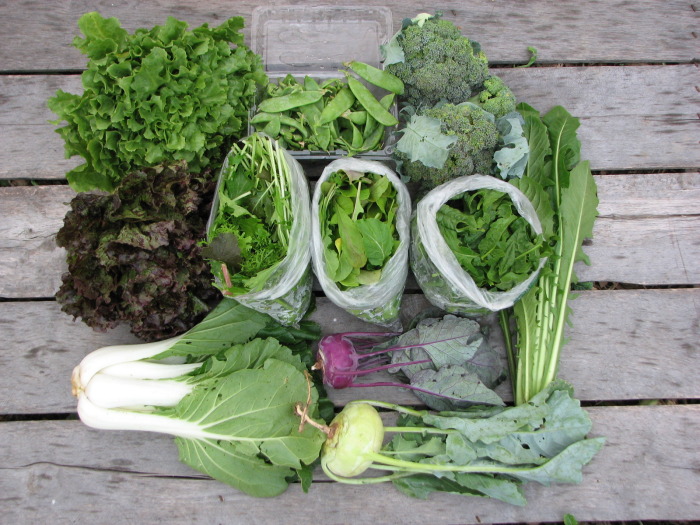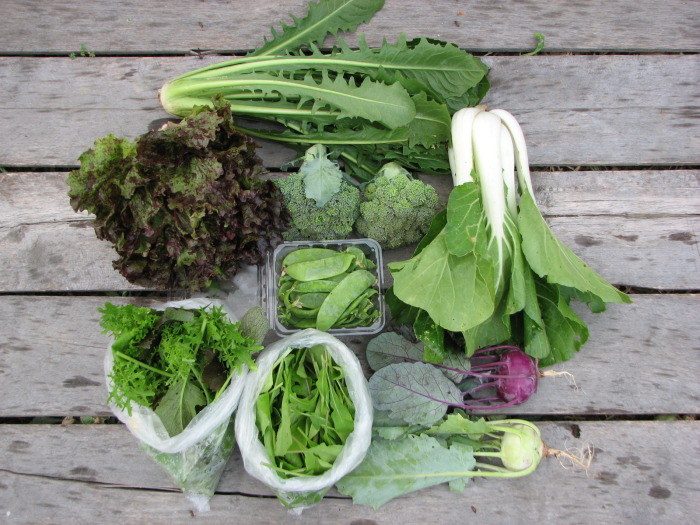Share Notes 5-11-17
CSA Share Notes:
With the warmer winter and warmer spring, we’re all already seeing that this is going to be quite a buggy year. Mosquitoes have been out in full force for some time I’m sure you’ve noticed, caterpillars found their way into your kitchen through your share last week, and this week don’t be surprised to find a new pest: Harlequin bugs. Yes, they’re back!
They don’t come every year, but those of you who remember the spring of 2014 will know that there are no organic pest control options that eliminate these little jerks, and that means within the next week or three, the brassica/mustard family of crops could be gone. This is why organic farming is hard, y’all. We’re trying to load your boxes up with this family of crops this week and next in case they wipe it out like they have in the past.
The brassica/mustard family include quite a large range: broccoli, kale, collard, radish, turnip, kohlrabi, arugula, tatsoi, pac choi, napa cabbage, regular cabbage… That’s a lot of food, y’all. So what we have from that family that is anywhere close to ready for you is going out in the shares ASAP. But don’t worry, this insect only feeds on those crops. There is no risk to other spring and summer crop families. All other families are doing quite well. Hooray!
So with that update, here’s your box! We hope you treasure what the garden has provided for you this week. (we’ve listed the Harlequin susceptible items with an asterisk so you’ll know what to especially cherish!)
- Kohlrabi*—small shares received two small kohlrabi, large shares received two large kohlrabi. This vegetable may be a newcomer to your kitchen. With kohlrabi, think: broccoli stems. Just peel off the tough outer skin and slice or chop. It’s crunchy and juicy like an apple, and a little bit sweeter than broccoli. Try with lemon juice and salt, it goes wonderfully into a salad, and it is also fantastic roasted.
- Arugula*—Our second planting of arugula is mature and ready for you!
- Pac Choi*—Win-win variety, a delicious Asian cabbage that’s a great addition to stir fries, curries, or turned into kim chee. We’ve got a great dish to recommend if you haven’t tried it yet! Sesame noodles with bok choy (pac choi and bok choy are the same plant, just two slightly different translations from Chinese)
- Escarole—This European salad green looks a LOT like lettuce, (check out the identifying images below) and has a deep flavor that some actually prefer cooked rather than eaten as a fresh salad. Some love it, some don’t! We hope you’ll give it a go and come to sing its praises as we have. Here’s a great write up for more info on this crop.
- Lettuce—our favorite spring lettuce variety is ready: Mottistone! We feel this lettuce is the most lovely variety we grow. Enjoy.
- Dandelion—This green is so amazing, but you have to treat it well. Its flavor is a little bitter. When learning to use new crops we often turn to the vegetable butcher over at Kitchn to teach us a thing or two. Here’s their recipe for an amazing dandelion pumpkin seed pesto we love and a pro tip: when you don’t know what to do with all these greens, grab some nuts and some hard cheese, and make a new creative pesto! Pesto typically freezes well too, so you can extend the harvest.
- Asian greens mix*—This flavorful mix of greens makes a fantastic salad, and are also great braised or sautéed. Each green was carefully selected for color, texture, and flavor.
- Broccoli*—I am confident you’ll have no trouble coming up with ides for this crop!
- Spinach— Another tender bag of this delectable green that is nearing the end of its season.
- Snow Peas—Crisp and juicy, these are excellent in a fresh salad, but they’re also great sautéed in butter.
Veggie Storage tips:
The many leafy greens will all last longest stored in the refrigerator, sealed up in bags or containers to retain their moisture. The root crops should be removed from their tops to keep the roots from getting rubbery. The tops can be stored like other greens. Everything will need a gentle washing before cooking, but leave the dirt on until you’re ready to use them. As a general rule, wait to wash any veggies until you’re ready to use them to help retain nutrients and prevent spoilage from excess moisture.
We’d love to hear stories and recipes of your culinary adventures this week. Send us a note or post a comment of how you’ve used your CSA share.
Your farmers,
Jess & Justin
 Large Share: (top row) Escarole, snow peas, broccoli, (2nd row) mottistone lettuce, bagged Asian greens mix, bagged arugula, and bagged spinach, dandelion greens, (bottom row) pac choi, and kohlrabi.
Large Share: (top row) Escarole, snow peas, broccoli, (2nd row) mottistone lettuce, bagged Asian greens mix, bagged arugula, and bagged spinach, dandelion greens, (bottom row) pac choi, and kohlrabi.